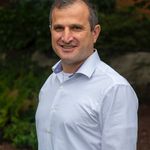Keynote Address – Dr. Garegin Papoian
Towards Simulating Eukaryotic Cells from the Fundamental Physico-Chemical Principles
ABSTRACT:
Cells of higher organisms contain a dynamically remodeling filamentous network, called cytoskeleton, comprised of actin, myosin and many other molecules. The cytoskeleton endues cells with their instantaneous shapes, providing a machinery for cells to move around, generate forces and also integrate both chemical and mechanical signaling. In terms of the physico-chemical mechanisms, the underlying acto-myosin network growth and remodeling processes are based on a large number of chemical and mechanical interactions, which are mutually coupled, and spatially and temporally resolved. To investigate the fundamental principles behind the self-organization of these networks, we have developed a detailed physico-chemical, stochastic model (MEDYAN, http://medyan.org) of the cytoskeletal dynamics, where the mechanical rigidity of filaments and their corresponding deformations under internally and externally generated forces are taken into account. We have also developed a flexible membrane model that interacts mechanically and chemically with both solution and gel phases, enabling simulations of vesicles containing a chemically active cytoskeleton. I will discuss our recent progress in simulating multi-micron scale cytosolic/cytoskeletal dynamics at 1000 seconds timescale, and also highlight the outstanding challenges in bringing about the capability for routine molecular modeling of eukaryotic cells.
BIOGRAPHICAL SKETCH:
 Dr. Papoian received his Ph.D. at Cornell University under guidance of Dr. Roald Hoffmann. He continued with postdoctoral work with Dr. Michael Klein and Dr. Peter Wolynes, studying quantum and protein physics. He has held faculty positions at the University of North Carolina at Chapel Hill and subsequently at the University of Maryland, College Park. He is currently the first Monroe Martin Professor at the University of Maryland, in the Department of Chemistry and Biochemistry and Institute for Physical Science and Technology. He received Beckman Young Investigator, Camille Dreyfus Teacher-Scholar and National Science Foundation CAREER awards. among others. He uses computational chemistry, physics and machine learning to study biological processes at multiple scales, from protein dynamics and epigenetics to cellular level processes, such as immune cell activation and neuronal dynamics.
Dr. Papoian received his Ph.D. at Cornell University under guidance of Dr. Roald Hoffmann. He continued with postdoctoral work with Dr. Michael Klein and Dr. Peter Wolynes, studying quantum and protein physics. He has held faculty positions at the University of North Carolina at Chapel Hill and subsequently at the University of Maryland, College Park. He is currently the first Monroe Martin Professor at the University of Maryland, in the Department of Chemistry and Biochemistry and Institute for Physical Science and Technology. He received Beckman Young Investigator, Camille Dreyfus Teacher-Scholar and National Science Foundation CAREER awards. among others. He uses computational chemistry, physics and machine learning to study biological processes at multiple scales, from protein dynamics and epigenetics to cellular level processes, such as immune cell activation and neuronal dynamics.
